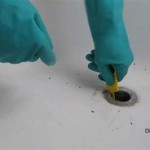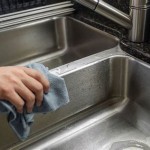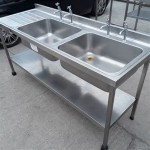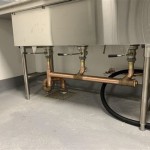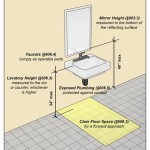Sink Water Shut Off Valve
A sink water shut off valve, also known as a stop valve, is a crucial component of any sink's plumbing system. It allows you to quickly and easily turn off the water supply to the sink, making it essential for repairs, maintenance, or emergencies.
Sink water shut off valves are typically located underneath the sink, near the base of the faucet. They are usually made of brass or plastic and have a handle or knob that you can turn to open or close the valve. Some valves have a quarter-turn handle, while others require multiple turns to fully open or close.
It is important to know where the water shut off valve is located for your sink, as well as for other fixtures in your home. In the event of a leak or burst pipe, being able to quickly shut off the water supply can help prevent significant water damage. It is also useful when replacing or repairing faucets, as it allows you to isolate the water supply to the sink without having to turn off the main water supply to your home.
Types of Sink Water Shut Off Valves
There are several different types of sink water shut off valves available, each with its own advantages and disadvantages:
- Compression valves: Compression valves are the most common type of sink water shut off valve. They work by compressing a washer against a seat to stop the flow of water. Compression valves are relatively inexpensive and easy to repair, but they can be prone to leaks over time.
- Gate valves: Gate valves use a gate to block the flow of water. They are more durable than compression valves and less likely to leak, but they can be more difficult to turn on and off.
- Ball valves: Ball valves use a ball with a hole through it to control the flow of water. They are very durable and easy to operate, but they can be more expensive than other types of valves.
- PEX valves: PEX valves are made of a flexible plastic material. They are easy to install and can be used in a variety of applications. However, they are not as durable as metal valves and may be more susceptible to leaks.
Choosing the Right Sink Water Shut Off Valve
When choosing a sink water shut off valve, there are a few factors to consider:
- Type of sink: The type of sink you have will determine the type of water shut off valve you need. For example, a kitchen sink will require a different valve than a bathroom sink.
- Size of the water line: The size of the water line that supplies water to your sink will determine the size of the shut off valve you need. Most sink water shut off valves are available in 1/2-inch, 3/4-inch, and 1-inch sizes.
- Material: Sink water shut off valves are typically made of brass or plastic. Brass valves are more durable, but they can be more expensive than plastic valves. Plastic valves are less durable, but they are more affordable and easier to install.
- Features: Some sink water shut off valves have additional features, such as a built-in vacuum breaker or a lever handle. These features can be useful, but they can also increase the cost of the valve.
Installing a Sink Water Shut Off Valve
Installing a sink water shut off valve is a relatively simple process. However, it is important to follow the manufacturer's instructions carefully to ensure that the valve is installed properly.
To install a sink water shut off valve, you will need the following tools and materials:
- Adjustable wrench
- Plumber's tape
- New sink water shut off valve
- Bucket or pan
Once you have gathered your tools and materials, follow these steps to install the sink water shut off valve:
- Turn off the water supply to the sink. You can do this by turning off the main water valve to your home or by closing the individual shut off valves under the sink.
- Open the faucet to release any remaining water from the line.
- Place a bucket or pan under the sink to catch any water that may leak.
- Using an adjustable wrench, loosen the nuts that hold the old shut off valve in place.
- Remove the old shut off valve and wrap the threads of the new shut off valve with plumber's tape.
- Screw the new shut off valve into place and tighten the nuts.
- Turn on the water supply and check for leaks.
- If there are any leaks, tighten the nuts further until the leak stops.
Maintaining Sink Water Shut Off Valves
Sink water shut off valves require very little maintenance. However, it is a good idea to inspect them periodically for leaks. If you notice any leaks, tighten the nuts that hold the valve in place.
If you are unable to stop a leak by tightening the nuts, you may need to replace the shut off valve. Replacing a sink water shut off valve is a relatively simple process that can be completed in a few minutes.

How To Install Shut Off Valves The Home

How To Remove Install A Leaky New Shut Off Valve Compression Soldered Or Push Fit Got2learn

Types Of Water Shut Off Valves The Home

How To Install Water Shutoff Valves In Kitchen Sink 1 4 Turn Valve Youtube

Quick Somebody Shut Off The Water

How To Rebuild A Shut Off Valve The Home

How To Install Water Shut Off Valve For Sinks

Plumbing Hot Water Supply Line Stopped Home Improvement Stack Exchange

Accessible Water Shut Off Valve And A New Sink Your Plumber Heating Air

Complete Set 1 2 In Nom Inlet X 3 8 Od Compression Outlet Angle Shut Off Valve Escutcheon Plate 20 Long Stainless Steel Braided Faucet Water Supply Line Pack Wal Com
